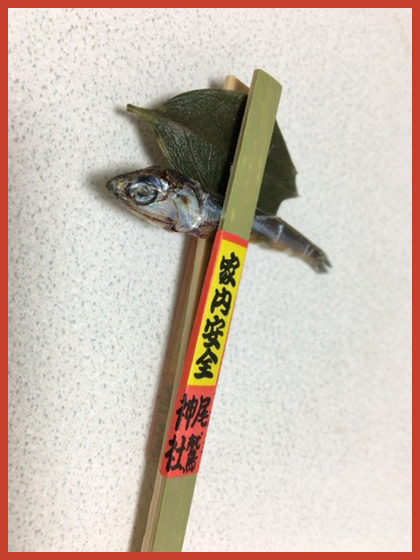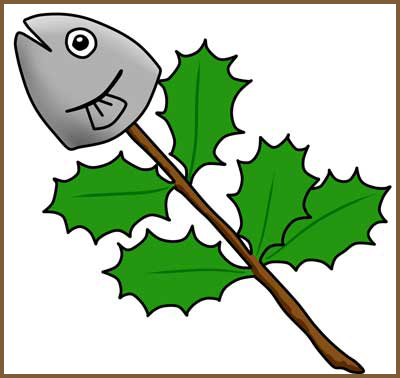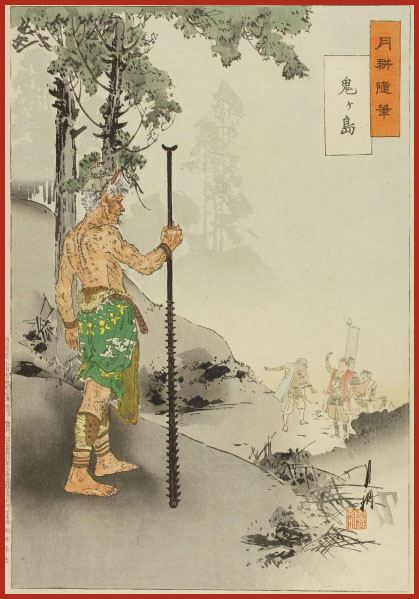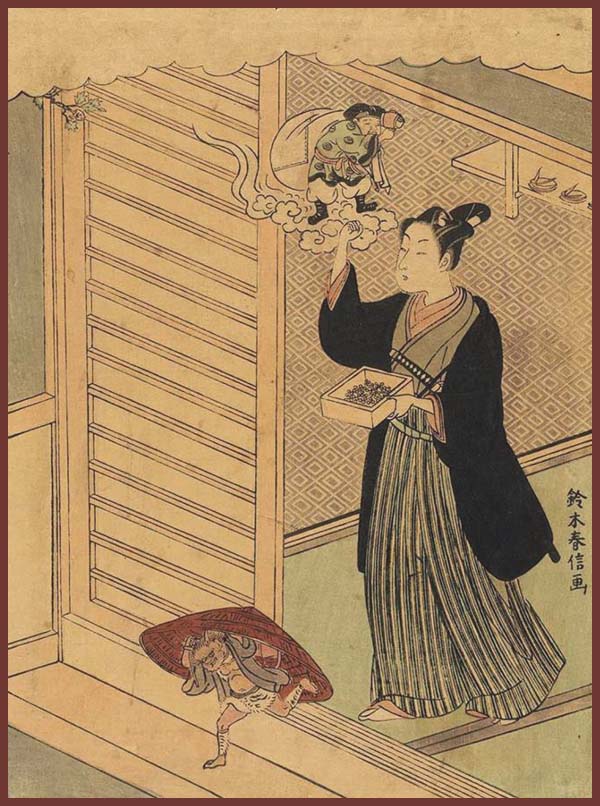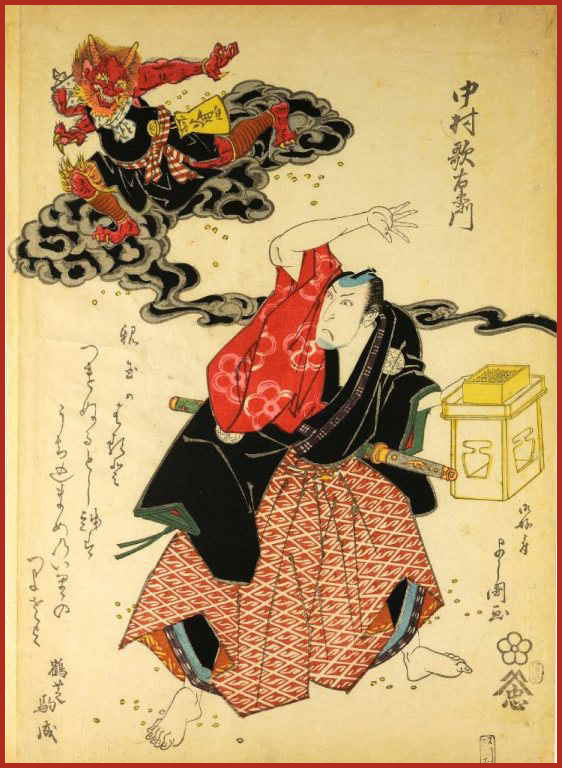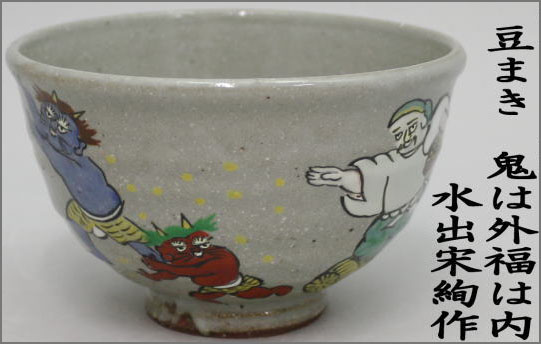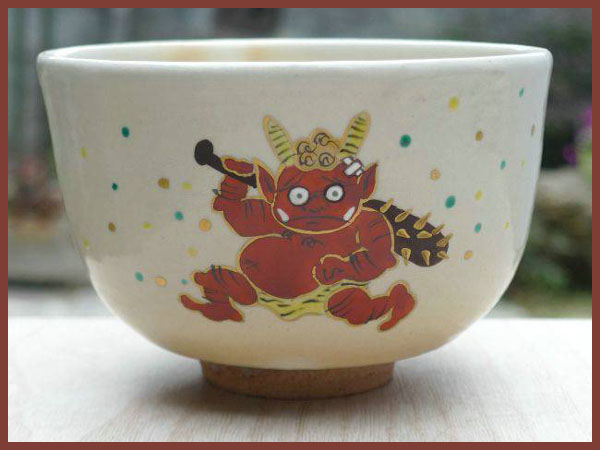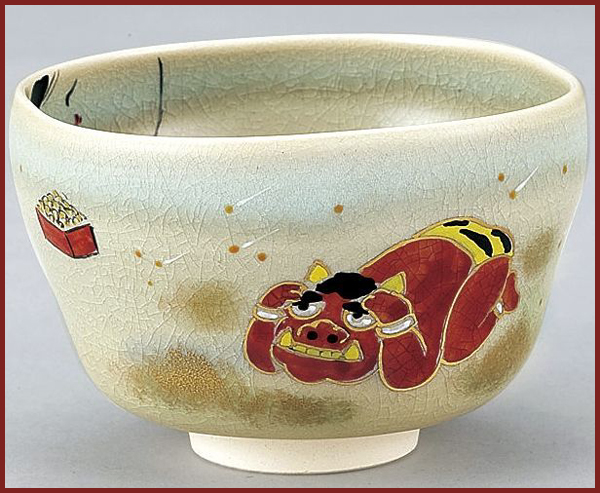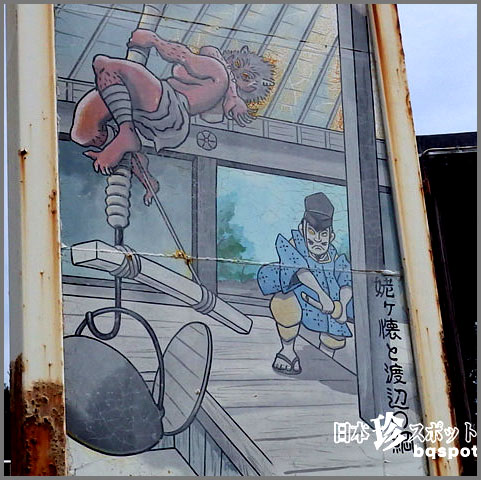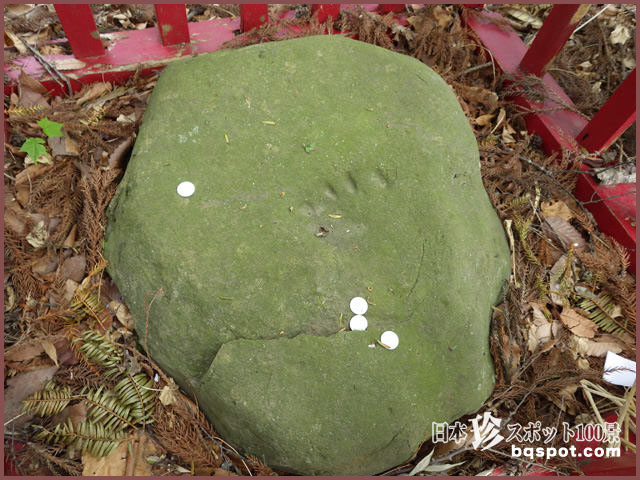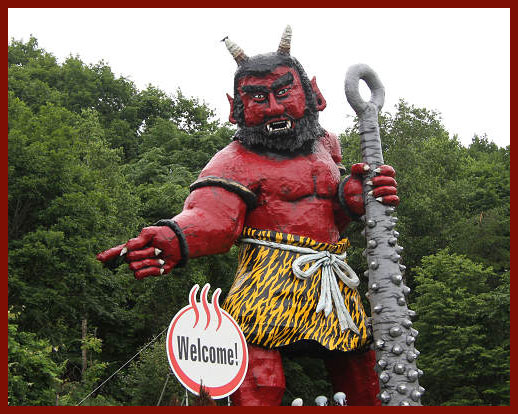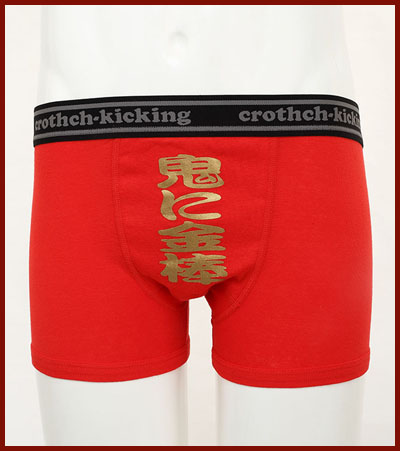. Onipedia - 鬼ペディア - Oni Demons - ABC-List - .
:::::::::::::::::::::::::::::::::::::::::::::::::::::::::::::::::::::::::::::::::::::::::::::::::::::::::::::::::::::::::::::::::::::::::::::::::::::::::::::::::::::::::::::::::::
The normal chant for the Setsubun rituals is :
oni wa soto 鬼は外 "Demons, get out!"
「鬼は―外! 福は―内!」
. setsubun 節分 "seasonal divide" rituals - Introduction .
on February 3, the day before the beginning of spring (risshun 立春) according to the Asian lunar calendar.
For Setsubun, there are usually two demons, Aka-Oni 赤鬼 Red Demon and Ao-Oni 青鬼 Blue/Green Demon. They have two horns and two eyes.
oniuchimame, oni uchi mame 鬼打豆 beans to throw at the demons
..... oni no mame 鬼の豆"beans for the demons
and the famous call accompanying the throwing of the beans :
oni wa soto 鬼は外 "Demons, get out! -
fuku wa uchi 福は内 "Good luck, come in!"
:::::::::::::::::::::::::::::::::::::::::::::::::::::::::::::::::::::::::::::::::::::::::::::::::::::::::::::::::::::::::::::::::::::::::::::::::::::::::::::::::::::::::::::::::::
But there are some regions in Japan
where the Oni are welcomed into the home - for various reasons.
oni wa uchi 鬼は内 Demons come in!
oni MO uchi 鬼も内
(Good luck come in and) Demons also come in!
There are three places in Nara prefecture, where the Demons are welcomed into the home !
01 - 「福は内、鬼は内」- Fuku wa Uchi, Oni wa Uchi!
- 元興寺 Temple Gango-Ji (奈良県奈良市)
A demon named Gagoze 元興神 drives out evil.
The name of this demon is also spelled 元興寺 / ガゴジ / ガンゴジ

元興寺節分絵馬 ema votive tablet with Gagoze
その昔、元興寺の鐘楼に悪霊の変化である鬼が出て、都の人たちを随分こわがらせたことがあります。その頃、尾張国から雷の申し子である大力の童子が入寺し、この鬼の毛髪をはぎとって退治したという有名な説話があります。
この話から、邪悪な鬼を退治する雷を神格化して、八雷神とか元興神と称することになり、鬼のような姿で表現するようになりました。元興寺にまつわる鬼のことをガゴゼとかガゴジとかガンゴなどの発音で呼ばれ、日本全国にも伝わっているようです。
(さらに詳しい解説はこちら「元興寺の鬼」)and even more details
- reference source : gangoji.or.jp/tera/jap/annai/gagoze -
- quote -
Gagoze
Gagoze is a horrible-looking ghost who haunts the ancient temple Gango-ji in Nara prefecture. His story dates back to the Asuka period (550-710 CE). He is first depicted in illustration in Toriyama Sekien’s Gazu Hyakki Yakko, and he is said to take the appearance of a demon in monk’s garb.
His story says
that during the time of Emperor Bidatsu, in old Owari province (now Nagoya in Aichi prefecture), lightning struck the ground near an farmer’s house. From the lightning emerged a thunder god in the form of a young boy, and the farmer ran outside with a stick to kill the boy. The boy pleaded with the farmer to spare his life, and promised that he would return the deed by giving the farmer and his family a young boy as strong as the thunder god. The farmer agreed, and allowed the thunder god to return to the sky.
Sure enough,
the farmer’s wife soon bore a child, and the child was as strong as a thunder god! However, the child was born with a snake wrapped around his head, with the head and tail going down the back like a ponytail. When the boy turned 10, he had grown so strong and proud that he challenged a member of the imperial family to a contest of strength and won.
After this,
the boy was apprenticed to Gango-ji temple. Shortly after that, the belltower boys began dying very strange deaths one-by-one, and rumors began to spread that an oni, or demon, was behind the deaths. The boy wanted to solve the mystery, so he said he would catch the oni. He waited all night by the belltower, and towards dawn finally the oni came. The boy grabbed the oni by the hair and dragged him around so hard that he ripped his entire scalp off, and the oni was able to escape. The boy followed the blood trail left by the oni all the way to its end, where he found the grave of a (former) very lazy and bad temple servant. The lazy servant’s ghost had become this terrible ghost-demon, and the boy had defeated it! The boy became famous and grew up to be a priest at the temple, and the oni’s scalp became one of the holy treasures of Gango-ji.
The story doesn’t really tell too much about the yokai itself, but it does at least explain who Gagoze was: a lazy priest-servant-turned-demon-ghost who liked to kill children! ...
- source : Matthew Meyer -

source : fukunaga.deviantart.com/art/Gagoze
- quote -
Wie es kam, dass einer dem Donner einen Gefallen tat
und ihm ein Kind von großer Kraft geboren wurde.
Zur Zeit des Bidatsu Tennō 敏達天皇,
in der Provinz Owari 尾張国, bewässerte ein Bauer ein Reisfeld, als es zu regnen begann und der Blitz vor ihm einschlug. Der Blitz nahm die Gestalt eines Kindes an. Der Bauer wollte das Kind mit einer Stange züchtigen, wurde aber vom Kind angehalten es zu verschonen. Als Gegenleistung werde es ihm seine Nachsicht mit einem Kind belohnen, wenn der Bauer ihm ein Kampferboot baue.
Kurze Zeit später
wurde dem Bauer ein Kind geboren, das eine zweimal herumgewundene Schlange um den Kopf hatte. Als das Kind sein Jugendalter erreichte, hörte es von einem starken Prinz der nordöstlich des Kaiserlichen Palast lebte. Also machte er sich auf die Stärke dieses Prinzen auszutesten. Es kam zu einem Weitwurfwettbewerb mit einem schweren Stein zwischen dem Knaben und dem starken Prinz. Als der Prinz dem ebenfalls kräftigen Knaben unterlag, versuchte er diesen zu fassen, schaffte es aber nicht ihn einzuholen. So musste er den Knaben als ihm überlegen anerkennen. Einige Zeit später wurde der Knabe ein Gefolgsmann des Gangō-Tempel 元興時. Dort wurde jede Nacht ein Novize des Tempels ermordet. Der Knabe nahm sich vor, dem ein Ende zu setzen. Er vertrieb den Unhold, nachdem er ihm alle Haare ausgerissen hatte, erfolgreich. Dies stellte sich als der Geist eines schlechten Tempeldieners 悪奴 heraus.
Der Knabe
wurde ein Laienmönch und lebte weiter im Gangō-ji. Als die Prinzen die Bewässerung der Felder des Tempels verhindern wollten, nahm er einen Stein der zu schwer für 100 Männer war und blockierte den Zugang zur Wasseröffnung. Die Prinzen waren verschreckt von seiner Stärke und ließen den Tempel fortan in Ruhe.
Der Laienmönch wurde bekannt als
Dharma Meister Dōjō 道場法師, der Held des Gangō-ji. Seine enorme Kraft war die Belohnung für Wohltaten in seinen vergangenen Leben.
- source : univie.ac.at/rel_jap/ryowiki -

鳥山石燕『画図百鬼夜行』Toriyama Sekien
. Gangōjil 元興時 Temple Gango-Ji .
..............................................................................................................................................
02 - 鬼は内、福は内」- Oni wa Uchi, Fuku wa Uchi !
- 天河神社 - Tenkawa Jinja
On the eve of Setsubun, the shrine becomes the home of the oni 鬼の宿 until the rituals are over.
February 2 - 鬼の宿(神迎えの神事)
The Oni get にぎりめし O-Nigiri rice balls and 梅干し Umeboshi dried plums for dinner.

The shrine is relate to the Demons Zenki and Goki.
天河社社家は、役行者の供に祀られております前鬼、後鬼の子孫と言い伝えられており、節分祭宵の晩『鬼の宿』として、先祖である鬼(神)をお迎えします。かつて天川の民が新しい年(節分)を迎える前夜、里宮を通して祖先の霊を迎えた古い信仰の名残りともいわれる神仏習合の神事です。
- HP of the Shrine
奈良県吉野郡天川村坪内107
- reference source : tenkawa-jinja.or.jp -
.......................................................................
奈良県 Nara 天川村 / 天河 Tenkawa
. the Demon Zenki 前鬼 and his wife Goki 後鬼 .
At the home of the 柿阪秀元氏 Kakisaka Hidemoto family, on the eve of the Setsubun ritual in spring, they place ritual water at the entrance and prepare a special seat for the Oni to take a rest.
They do not pierce the head of a sardine (a custom to drive away the Oni), and they call
"Fuku wa Uchi, Oni wa Uchi" May good luck come in, may the Demon come in!
The family is said to have Zenki and Goki as their ancestors.
The shrine 天河神社 Tenkawa Jinja also sells an amulet for
. shogei jootatsu 諸芸上達守 progress in all arts .
.......................................................................
oni no shison 鬼の子孫 / onisuji 鬼筋 descendants of the Oni
Near the temple 安生寺 Ansho-Ji there are five families, who do NOT prepare chimaki 粽 ritual rice dumplings for the Boy's festival on May 5th and hishimochi 菱餅 red and white dumplings for the Girls's festival on May 3.
These families claim to be descendants of the Demons (Zenki and Goki). The Chimaki look like the tsuno 角 horns of an Oni and the Hishimochi look like oni no shita 鬼の舌 the tongue of an Oni, thus they feel it an insult against the ancestors to prepare them.
During the Setsubun rituals, they never chant
oni wa soto 鬼は外 but only fuku wa uchi 福は内.
. oni no shison 鬼の子孫 / onisuji 鬼筋 - descendants of Oni .
..............................................................................................................................................
03 「福は内、鬼も内」- Fuku wa Uchi, Oni mo Uchi!
金峯山寺蔵王堂(奈良県吉野郡吉野町)Kinpusen-Ji, Zao-Do
Many demons that are driven out at Setsubun come here for a rest. They are welcomed and some have a change of heart and become benevolent Oni afterwards.
The rituals on February 3 are called
onibi no saiten 鬼火の祭典 Onibi Festival


. . . CLICK here for more Photos !
. Kinpusenji Yoshino 金峯山寺 吉野山 Kinpusen-Ji .
Zaodoo 蔵王堂 Zaodo Hall for Zao Gongen
..............................................................................................................................................
There are other places in Japan, where the Demons are welcomed into the home !
「福は内、鬼は内」- Fuku wa Uchi, Oni wa Uchi!
- 稲荷鬼王神社 Inari Kio Jinja (新宿区歌舞伎町)Shinjuku, Tokyo
.......................................................................
「福は外、鬼は内」- Fuku wa Soto, Oni wa Uchi!
- 千蔵寺 Senzo-Ji (神奈川県川崎市)Kanagawa-ken, Kawasaki-shi, Kawasaki-ku, Nakaze, 3
- HP of the temple
- reference source : tesshow.jp/kanagawa/kawasaki -
.......................................................................
鬼は外」は禁句 - Oni wa soto is not allowed to chant.
大須観音 Osu Kannon
愛知県名古屋市中区大須2-21-47
. Oosu Kannon 大須観音 Osu Kannon .
.......................................................................
「福は内」 - only Fuku wa Uchi!
- 成田山新勝寺 Shinsho-Ji (千葉県成田市)

beans to invite the Oni in ! 招福豆
. Narita San 成田山 Shinshō-ji 新勝寺 .
.......................................................................
伝統的な商家 old merchant families chant only
「鬼は内」Oni wa Uchi !
The word ONI 鬼 is seen as a pun with 大荷 "a big load of merchandise", so to keep the business prosperous, they invite it inside.
- reference source : blog.narasaku.com -
:::::::::::::::::::::::::::::::::::::::::::::::::::::::::::::::::::::::::::::::::::::::::::::::::::::::::::::::::::::::::::::::::::::::::::::::::::::::::::::::::::::::::::::::::::

Oni wa uchi fuku wa soto
by Keisuke Nishimoto; Yutaka Murakami (Author)
:::::::::::::::::::::::::::::::::::::::::::::::::::::::::::::::::::::::::::::::::::::::::::::::::::::::::::::::::::::::::::::::::::::::::::::::::::::::::::::::::::::::::::::::::::
. Japanese Legends - 伝説 民話 昔話 – ABC-List .
.......................................................................
愛媛県 Aichi 越智郡 Ochi district 魚島村 Uoshimamura
For Setsubun, farmers put together a bunch of Susuki grass with leaves of メッツタ Metta and ホーベーの葉 Hoobee to ward off the Demons.
At home they use the normal chant for Setsubun 「福は内、福は内、鬼は外、鬼は外」.
On their fishing boats they chant:
「ふか外、ふか外、鬼は内、鬼は内」- Oni wa uchi!
Good Luck get out, Demons come in!
.......................................................................
石川県 Ishikawa 金沢市 Kanazawa
Once upon a time an Oni appeared at the home of the 富永家 Tominaga family and since that time, the family was blessed with good fortune.
Since then, they throw beans and chant at Setsubun
福は外鬼は内 Fuku wa soto, Oni wa uchi!
Once there was a fire in the castle town of Kanazawa. A black cloud in the form of an Oni appeared over their house and spread like an umbrella, protecting it from burning down.
:::::::::::::::::::::::::::::::::::::::::::::::::::::::::::::::::::::::::::::::::::::::::::::::::::::::::::::::::::::::::::::::::::::::::::::::::::::::::::::::::::::::::::::::::::
. - - - Join the Onipedia friends on facebook ! - - - .
:::::::::::::::::::::::::::::::::::::::::::::::::::::::::::::::::::::::::::::::::::::::::::::::::::::::::::::::::::::::::::::::::::::::::::::::::::::::::::::::::::::::::::::::::::
. Onipedia - 鬼ペディア - Oni Demons - ABC-List - .
. Tengu 天狗と伝説 Tengu legends "Long-nosed Goblin" .
. - yookai, yōkai 妖怪 Yokai monsters - .
. Legends and Tales from Japan 伝説 - Introduction .
. Mingei 民芸 Regional Folk Art from Japan .
:::::::::::::::::::::::::::::::::::::::::::::::::::::::::::::::::::::::::::::::::::::::::::::::::::::::::::::::::::::::::::::::::::::::::::::::::::::::::::::::::::::::::::::::::::
[ . BACK to DARUMA MUSEUM TOP . ]
[ . BACK to WORLDKIGO . TOP . ]
- #oniwasoto #onimamemaki #setsubun #oniwauchi #fukuwauchi #gagoze #gangoji -
:::::::::::::::::::::::::::::::::::::::::::::::::::::::::::::::::::::::::::::::::::::::::::::::::::::::::::::::::::::::::::::::::::::::::::::::::::::::::::::::::::::::::::::::::::










